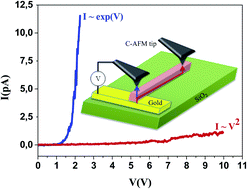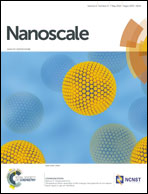Anisotropic charge transport in large single crystals of π-conjugated organic molecules
Abstract
The electronic properties of organic semiconductors depend strongly on the nature of the molecules, their conjugation and conformation, their mutual distance and the orientation between adjacent molecules. Variations of intramolecular distances and conformation disturb the conjugation and perturb the delocalization of charges. As a result, the mobility considerably decreases compared to that of a covalently well-organized crystal. Here, we present electrical characterization of large single crystals made of the regioregular octamer of 3-hexyl-thiophene (3HT)8 using a conductive-atomic force microscope (C-AFM) in air. We find a large anisotropy in the conduction with charge mobility values depending on the crystallographic orientation of the single crystal. The smaller conduction is in the direction of π–π stacking (along the long axis of the single crystal) with a mobility value in the order of 10−3 cm2 V−1 s−1, and the larger one is along the molecular axis (in the direction normal to the single crystal surface) with a mobility value in the order of 0.5 cm2 V−1 s−1. The measured current–voltage (I–V) curves showed that along the molecular axis, the current followed an exponential dependence corresponding to an injection mode. In the π–π stacking direction, the current exhibits a space charge limited current (SCLC) behavior, which allows us to estimate the charge carrier mobility.


 Please wait while we load your content...
Please wait while we load your content...